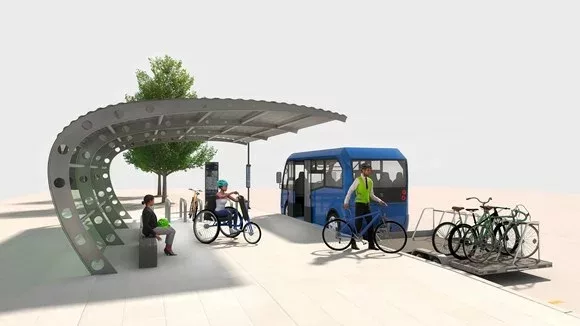Mayor and TfL committed to providing cross-river cycling service as part of the planning for the Silvertown Tunnel
Proposals include a new ‘cycle shuttle bus’ service to help cyclists with a range of different designs of bike to cross the river and safely travel from the Greenwich Peninsula to Canary Wharf and Silvertown
Proposed service will complement frequent zero-emission bus network which will provide swift and safe transport across the river via the new tunnel once it opens
Transport for London (TfL) has today launched an eight-week consultation setting out its proposals to allow cyclists to cross the Thames safely and comfortably as part of its long-standing commitments surrounding the Silvertown Tunnel.
The Silvertown Tunnel will address the chronic issues Londoners face at the Blackwall Tunnel as well as provide new cross-river public transport options by zero-emission buses. The tunnel, which lies within the existing Ultra Low Emission Zone, will link the Greenwich Peninsula on the south of the river with Silvertown on the north and along with the Blackwall Tunnel and be subject to a user-charge when it opens. Work on the tunnel is progressing, with construction of the second tunnel bore, as well as the new road layout, both well underway.
The Silvertown Tunnel has been in development for more than a decade, with public consultations on the scheme carried out in 2014, 2015 and a six-month public enquiry taking place as part of the planning process. At the request of the current Mayor of London, the scheme was reviewed in October 2016, with a series of enhancements made to the proposals to make it greener and more public transport-focused, and exploring further benefits for local residents who use the tunnel.
As part of the permission granted for the construction of the tunnel, the Mayor and TfL committed to investigating and delivering an alternative cross-river facility for cyclists, to be delivered by tunnel opening in 2025. The eight-week consultation sets out the proposals which TfL plans on implementing to help those wishing to cross from the Greenwich Peninsula to the areas around Silvertown and Canary Wharf do so in a safe and accessible way.
Based on work to date, the preferred and safest option is a new bespoke bus shuttle service for cyclists. A cycle shuttle bus would look to be accessible to a range of different bike designs and provide the best overall solution balancing cyclists’ needs, providing flexibility to respond to uncertain demand and value for money. The bus would be reserved for cyclists, with pedestrians able to use the expanded and high-frequency range of zero-emission bus routes that the new Silvertown Tunnel will support. The consultation includes indicative proposals for drop off and pick-up locations for the service, integrating with the existing cycle infrastructure north and south of the river.
The shuttle bus could operate as a ‘timetabled’ service starting with six buses per hour to give users better ability to plan their journey in advance with greater certainty, with the possibility to grow the service in future in response to demand. Feedback from the consultation will inform the final frequency, stop locations and route for the service to operate.
For the cycle-bus vehicle, there are two main options under consideration – a vehicle that allows cyclists and bikes on board, possibly with internal racks or storage areas, or a vehicle with a bicycle trailer fitted to the back. As the vehicles themselves have not been specified yet, their nature and design will be informed by feedback from the consultation alongside discussions with potential suppliers on the detailed options. Alongside the cycle bus shuttle service, the IFS Cloud Cable Car already provides an alternative way for cyclists to cross the river along the alignment of the Silvertown Tunnel.
With significant growth expected in the Greenwich Peninsula and Royal Docks area in the coming years, TfL is also asking respondents whether they would use a future new ferry service in the area. Such a service would require significant investment to deliver and is currently unaffordable. TfL is keeping this option under review in case the necessary investment for piers, boats and supporting infrastructure become available as part of local redevelopment.
Alongside these proposals, TfL is also working with Riverlinx CJV, who is delivering the Silvertown Tunnel, and the local boroughs on plans for wider improvements for walking and cycling around the areas near the tunnel entrances to support the major regeneration of both sides of the river. A new fully accessible walking and cycling bridge across the A102 has also recently been delivered and open to the public via a temporary ramp.
The Walking and Cycling Commissioner, Will Norman said: “Making cycling easier and more attractive to Londoners is a top priority for the Mayor. These plans will mean that cyclists will benefit from easier travel between the Greenwich Peninsula and Silvertown, enabling more people to make the switch to active travel and helping to build a better, greener London for everyone. I encourage Londoners to have their say in TfL’s consultation and let us know how this innovative service could best serve them.”
David Rowe, Director of investment and Delivery Planning at TfL said: “These cross-river cycling proposals are a key part of our commitment to ensuring that the Silvertown Tunnel supports growth in cross-river cycling use. We are keen to hear feedback from existing and potential cyclists so we can ensure that the services that are implemented best represent the needs of those who would use them.
“Work on the Silvertown Tunnel continues to progress, and we are working hard to ensure that this essential new infrastructure delivers transformative benefits to cross-river travel in east London with minimal impact to local communities. We will continue to engage with the local community and monitor traffic, air quality and other factors, both during construction and once the tunnel is open.”
The consultation will run until 10 September 2023 and the final decision on the proposals will be taken later this year once all responses have been analysed.






















